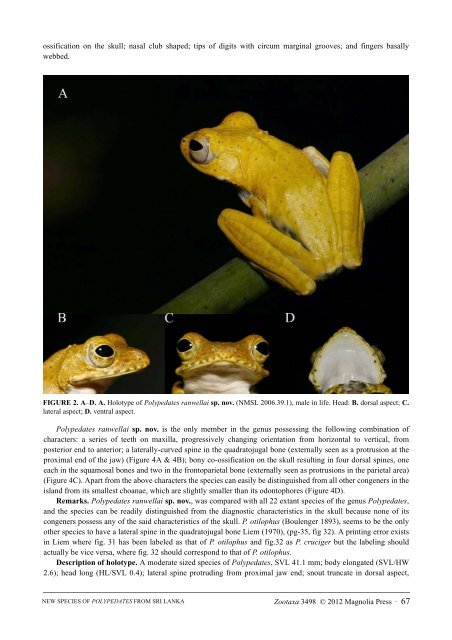Identification of Novel Species by Herpetological Foundation of Sri Lanka in Collaboration with Dilmah Conservation
Dilmah Conservation in collaboration with Herpetological Foundation of Sri Lanka has implemented a project on identification of new species of Herpetofauna, which will generate scientific evidence on their existence and promote conservation. This is the article published in Zootaxa Journal on the first new species identified as result of this research project – a species of Polypedates Tschudi …
Dilmah Conservation in collaboration with Herpetological Foundation of Sri Lanka has implemented a project on identification of new species of Herpetofauna, which will generate scientific evidence on their existence and promote conservation. This is the article published in Zootaxa Journal on the first new species identified as result of this research project – a species of Polypedates Tschudi …
You also want an ePaper? Increase the reach of your titles
YUMPU automatically turns print PDFs into web optimized ePapers that Google loves.
TERMS OF USE<br />
This pdf is provided <strong>by</strong> Magnolia Press for private/research use.<br />
Commercial sale or deposition <strong>in</strong> a public library or website is prohibited.<br />
ossification on the skull; nasal club shaped; tips <strong>of</strong> digits <strong>with</strong> circum marg<strong>in</strong>al grooves; and f<strong>in</strong>gers basally<br />
webbed.<br />
FIGURE 2. A–D. A. Holotype <strong>of</strong> Polypedates ranwellai sp. nov. (NMSL 2006.39.1), male <strong>in</strong> life. Head: B. dorsal aspect; C.<br />
lateral aspect; D. ventral aspect.<br />
Polypedates ranwellai sp. nov. is the only member <strong>in</strong> the genus possess<strong>in</strong>g the follow<strong>in</strong>g comb<strong>in</strong>ation <strong>of</strong><br />
characters: a series <strong>of</strong> teeth on maxilla, progressively chang<strong>in</strong>g orientation from horizontal to vertical, from<br />
posterior end to anterior; a laterally-curved sp<strong>in</strong>e <strong>in</strong> the quadratojugal bone (externally seen as a protrusion at the<br />
proximal end <strong>of</strong> the jaw) (Figure 4A & 4B); bony co-ossification on the skull result<strong>in</strong>g <strong>in</strong> four dorsal sp<strong>in</strong>es, one<br />
each <strong>in</strong> the squamosal bones and two <strong>in</strong> the frontoparietal bone (externally seen as protrusions <strong>in</strong> the parietal area)<br />
(Figure 4C). Apart from the above characters the species can easily be dist<strong>in</strong>guished from all other congeners <strong>in</strong> the<br />
island from its smallest choanae, which are slightly smaller than its odontophores (Figure 4D).<br />
Remarks. Polypedates ranwellai sp. nov., was compared <strong>with</strong> all 22 extant species <strong>of</strong> the genus Polypedates,<br />
and the species can be readily dist<strong>in</strong>guished from the diagnostic characteristics <strong>in</strong> the skull because none <strong>of</strong> its<br />
congeners possess any <strong>of</strong> the said characteristics <strong>of</strong> the skull. P. otilophus (Boulenger 1893), seems to be the only<br />
other species to have a lateral sp<strong>in</strong>e <strong>in</strong> the quadratojugal bone Liem (1970), (pg-35, fig 32). A pr<strong>in</strong>t<strong>in</strong>g error exists<br />
<strong>in</strong> Liem where fig. 31 has been labeled as that <strong>of</strong> P. otilophus and fig.32 as P. cruciger but the label<strong>in</strong>g should<br />
actually be vice versa, where fig. 32 should correspond to that <strong>of</strong> P. otilophus.<br />
Description <strong>of</strong> holotype. A moderate sized species <strong>of</strong> Polypedates, SVL 41.1 mm; body elongated (SVL/HW<br />
2.6); head long (HL/SVL 0.4); lateral sp<strong>in</strong>e protrud<strong>in</strong>g from proximal jaw end; snout truncate <strong>in</strong> dorsal aspect,<br />
NEW SPECIES OF POLYPEDATES FROM SRI LANKA<br />
Zootaxa 3498 © 2012 Magnolia Press · 67















